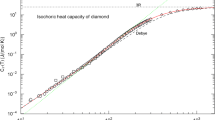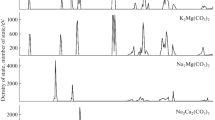Abstract
An analysis has been made of contributions to the heat capacity of Mo, with a special examination of the effect of the formation of vacancies near the melting point. Literature values of the heat capacity at constant pressure C P were fitted to a polynomial. Using recent measurements of the velocity of sound at high temperature and literature data of the coefficient of expansion, the dilation correction was made to C P to obtain the heat capacity at constant volume C V . This heat capacity was taken to consist only of independent contributions from electron excitations (C VE), harmonic lattice vibrations (C VH), anharmonic lattice vibrations (C VA), and the formation of vacancies (C VV). Three models of C VE (free electron, band theory, and electron-photon) have been used to calculate the electronic contribution, and an examination of the results indicates that the electron-phonon model is the best. C VH is assumed to be given by the Debye model, with a single Debye temperature. Thus, the excess heat capacity C VEX= C V -C VE -C VH is taken as equal to (C VA +C VV ), where C VA is linear with temperature (C VA=A T), and we have fitted the values of C VEX to determine the values of A and the energy and entropy of formation of vacancies which give the best fit. The anharmonic contribution is positive. The energy of vacancy formation is 100,000 J · mol−1, in agreement with estimates by Kraftmakher from C P data. The entropy of formation is 11.6 J · mol−1 · K−1. The concentration of vacancies at the melting point (2890 K) is calculated to be 6.3%.
Similar content being viewed by others
Reference
Ya. A. Kraftmakher, Sov. Phys.-Sol. State 6(2):396 (1964).
Ya. A. Kraftmakher, High Temp.-High Press. 5(4):433 (1973).
Ya. A. Kraftmakher, Issled. Vys. Temp. Akad. Nauk. SSSR-Sib. Otd., 5 (1966).
Ya. A. Kraftmakher, Scripta Met. 11:1033 (1977).
Ya. A. Kraftmakher, in Int. Symp.-Defect Interactions in Solids (I.I.S., Bangalore, India, 1972), p. 64.
Ya. A. Kraftmakher and P. G. Strelkov, in Proc. Int. Conf. Vacancies and Interstitials in Metals (North-Holland, Amsterdam, 1969), pp. 59–79.
M. Hoch, in ref. 6.
H. Schultz, Mat. Sci. Eng. 3:189 (1968–69).
M. Hoch, in Thermodyn. Nucl. Mat. Proc. Symp. 4th (IAEA, Vienna, Austria, 1975), Vol. 2, pp. 113–122.
M. Hoch, in Proc. Symp. Thermophys. Prop. 5 (ASME, New York, 1970), pp. 380–384.
K. Maier, M. Peo, B. Saile, H. E. Schaefer, and A. Seeger, Phil. Mag. A 40(5):701 (1979).
A. Seeger, Cryst. Lattice Defects 4(4):221 (1973).
R. W. Siegel, J. Nucl. Mat. 69–70: 117 (1978).
F. Simon and W. Zeidler, Z. Phys. Chem. 123:383 (1926).
K. Clusius and P. Franzosini, Z. Naturforsch. 14a:99 (1959).
L. M. Khriplovich and I. E. Paukov, J. Chem. Thermodyn. 15:333 (1983).
R. Hultgren, P. D. Desai, D. T. Hawkins, M. Gleiser, K. K. Kelley, and D. D. Wagman, Selected Values of the Thermodynamic Properties of the Elements (ASM, Metals Park, Ohio, 1973).
D. Cooper and G. Langstroth, Phys. Rev. 33:243 (1929).
T. Stern, Phys. Rev. 32:298 (1928).
H. L. Bronson, H. M. Chisholm, and S. M. Dockerty, Can. J. Res. 8:282 (1933).
F. M. Jaeger and W. A. Veenstra, Rev. Trav. Chim. 53:677 (1934).
T. A. Redfield and J. H. Hill, USAEC-ORNL (Oak Ridge National Laboratory, Oak Ridge, Tennessee, 1951).
M. Horowitz and J. G. Daunt, Phys. Rev. 31:1099 (1953).
C. F. Lucks and H. W. Deem, WADC Tech. Rept. 55-496, Battelle Memorial Inst., Columbus, Ohio (1956), p. 43.
I. B. Fieldhouse, J. C. Hedge, J. I. Lang, A. N. Takata, and T. E. Waterman, WADC Tech. Rept. 55-495 Part I, Wright Air Dev. Center, Wright-Patterson Air Force Base, Ohio (1956).
N. S. Rasor and J. D. McClelland, Phys. Chem. Solids 15:17 (1960).
L. S. Lazareva, P. B. Kantor, and V. V. Kandyba, Phys. Met. Metallog. 11:133 (1961).
G. W. Lehman, WADD Tech. Rept. 60-581, Atomics Int., Canoga Park, Calif. (1960).
V. A. Kirillin, A. E. Sheindlin, and V. Ya. Chekhovskoy, Dokl. Akad. Nauk. SSSR 139(3):645 (1961).
R. E. Taylor and R. A. Finch, Atomics Int. N.A.A., SR-6034, Canoga Park, Calif. (1961).
G. C. Lowenthal, Aust. J. Phys. 16:47 (1963).
R. L. Rudkin, W. J. Parker, and R. J. Jenkins, Temp. Meas. Cont. Sci. Ind. 3:523 (1962).
V. A. Kirillin, A. E. Sheindlin, and V. Ya. Chekhovskoy, High Temperature Technology, IUPAC-Proc. Int. Symp. High Temp. Tech. (Butterworths, London, 1964), pp. 471–484.
V. A. Kirillin, A. E. Sheindlin, V. Ya. Chekhovskoi, and V. A. Petrov, Teplofiz. Svoistva. Veshchestv. (Leningrad Teckhnol. Inst. Kholod. Prom., Leningrad, U.S.S.R., 1969), Vol. 3, pp. 80–87.
I. N. Makarenko, L. N. Trukhanova, and L. P. Fillipov, High Temp. 8(2): 416 (1970).
I. Ya. Dikhter and S. V. Lebedev, High Temp. 9(5):845 (1971).
A. Cezairliyan, M. S. Morse, H. A. Berman, and C. W. Beckett, J. Res. Natl. Bur. Stand. 74(a):65 (1970).
B. Ya. Berezin, V. Ya. Chekhovskoi, and A. E. Sheindlin, High Temp.-High Press. 3:287 (1971).
M. M. Mebed, R. P. Yurchak, and L. P. Filippov, High Temp.-High Press 5(3):253 (1973).
V. Ya. Chekhovskoi and B. Ya. Berezin, Teplofiz. Svoistva. Tverd. Veshchestv. Mater. Konf. 4 (Nauka, Moscow, U.S.S.R., 1973), pp. 128–134.
V. B. Fedorov, High Temp. 13(3):608 (1975).
V. Ya. Chekhovskoi and R. G. Kalinkina, Zh. Fiz. Khim. 49(3):740 (1975).
S. V. Lebedev, A. I. Savvatimskii, and M. A. Sheindlin, High Temp. 14(2):259 (1976).
G. A. Zhagrina, L. R. Fokin, and V. Ya. Chekhovskoi, Teplofiz. Svoistva. Veschestv. Pri. Vysok. Temp., 1978 (Ref. Zh. Fiz. E., Abstr. No. 1E327, 1979).
D. A. Ditmars, A. Cezairliyan, S. Ishihara, and T. B. Douglas, Enthalpy and Heat Capacity Standard Reference Material: Molybdenum SRM781, From 273 to 2800 K, N.B.S. Spec. Publ. 260-55-1977.
V. A. Korshunov, Phys. Met. Metallog. 41(2):54 (1976).
A. G. Worthing, Phys. Rev. 28(1):190 (1926).
F. C. Nix and D. MacNair, Phys. Rev. 61:74 (1942).
J. Demarquay, Compt. Rend. 220(2):81 (1945).
J. W. Edwards, R. Speiser, and H. L. Johnston, J. Appl. Phys. 22(4):424 (1951).
W. R. Apblett and W. S. Pellini, Trans. Am. Soc. Met. 44(6):1200 (1952).
E. E. Totskii, High Temp. 2(2):181 (1964).
V. M. Amonenko, P. N. V'yugov, and V. S. Gumenyuk, High Temp. 2(1):22 (1964).
J. B. Conway, R. A. Hein, R. M. Fincel, and A. C. Losekamp, Enthalpy and Thermal Expansion of Several Refractory Metals to 2500°C, USAEC. Publ-GE-TM-64-2-8 (General Electric Co., Cincinnati, Ohio, Advanced Technology Services, Feb. 1964).
R. Pawar, Curr. Sci. 36(16):428 (1967).
M. E. Straumanis and R. P. Shodhan, Trans. Met. Soc. (AIME) 242:1185 (1968).
C. L. Woodard, X-ray determination of lattice parameters and thermal expansion coefficients of aluminum, silver and molybdenum at cryogenic temperatures, Diss. Abstr. Int. B 1970, 31(1):225 (1969).
V. P. Lebedev, A. A. Mamlui, V. A. Pervakov, N. S. Petrenko, V. P. Popov, and V. I. Khotkevich, Ukr. Fiz. Zh. 14(5):746 (1969).
A. P. Nasekovskii, Izv. Vys. Ucheb. Zaved. Fiz. 12(1):65 (1969).
J. Valentich, Instrum. Contr. Syst. 42(10):91 (1969).
V. Ya. Chekhovskoi and V. A. Petukhov, in Proc. 5th Symp. Thermophys. Prop. (ASME, New York, 1970), pp. 366–372.
M. E. Straumanis and C. L. Woodard, Acta. Cryst. A27(6):549 (1971).
V. A. Petukhov and V. Ya. Chekhovskoi, High Temp.-High Press. 4(6):671 (1972).
Yu. A. Lisovskii, Sov. Phys.-Sol. State 14:2015 (1973).
Y. Waseda, K. Hirata, and M. Ohtani, High Temp.-High Press. 7(2):221 (1975).
A. N. Amatuni, T. I. Malyutina, V. Ya. Chekhovskoi, and V. A. Petukhov, High Temp.-High Press. 8(5):565 (1976).
V. A. Petukhov, V. Ya. Chekhovskoi, and A. G. Mozgovoi, High Temp. 15(1):175 (1977).
G. K. White, T. F. Smith, and R. H. Carr, Cryogenics 18(5):301 (1978).
Handbook of Chemistry and Physics, R. C. Weast, ed., 55th ed. (CRC, 1974–75).
J. M. Dickinson and P. E. Armstrong, J. Appl. Phys. 38(2):602 (1967).
P. Bujard, R. Sanjines, E. Walker, J. Ashkenazi, and M. Peter, J. Phys. F. 11:775 (1981).
F. H. Featherson and J. R. Neighbours, Phys. Rev. 130:1327 (1963).
V. T. Seidenkranz and E. Hegenbarth, Exp. Technik Physik (Berlin) 26(1):13 (1978).
M. W. Zemansky, Heat and Thermodynamics, 3rd ed. (McGraw-Hill, New York, 1951).
K. A. Gscheidner, Sol. State Phys. 16:275 (1964).
J. A. Beattie, J. Math. Phys. (MIT) 6:1 (1926).
D. C. Rorer, D. G. Orr, and H. Meyer, Phys. Rev. 138:1661 (1965).
N. M. Wolcott, Conf. Phys. Des Bass. Temp., Bulletin de l'Institut International du Froid, Annexe, 286 (1955).
M. Shimizu, Natl. Bur. Stands. (U.S.) Spec. Pub. 323 (1971), pp. 685–691.
M. Shimizu, A. Katsuki, and K. Ohmori, J. Phys. Soc. Japan 21(10): 1922 (1966).
G. Grimvall, Phys. Kondens. Mat. 11:279 (1970).
G. Grimvall, J. Phys. Chem. Solids 29:1221 (1965).
G. Grimvall, Phys. Scripta 14:63 (1976).
I. Petroff and C. R. Vishwanathan, Natl. Bur. Stands. (U.S.) Spec. Publ. 323 (1971), pp. 53–56.
R. C. Shukla, Int. J. Thermophys. 1(1):73 (1980).
V. A. Korshunov, Phys. Met. Metallog. 48(1):53 (1979).
J. D. Meakin, A. Lawley, and R. C. Koo, Lattice Defects in Quenched Metals-Proc. Int. Conf. (Academic Press, New York, 1965), pp. 767–769.
M. Suezawa and H. Kimura, Phil. Mag. 28(4):901 (1973).
I. A. Schwirlich and H. Schultz, Phil. Mag. A 42(5):601 (1980).
A. Seeger and H. Mehrer, in ref. 6.
J. Nihoul, in ref. 6.
T. Gorecki, Z. Metallk. 65(4):426 (1974).
R. O. Simmons and R. W. Balluffi, Phys. Rev. 129(4): 1533 (1963).
Author information
Authors and Affiliations
Rights and permissions
About this article
Cite this article
Choudhury, A., Brooks, C.R. Contributions to the heat capacity of solid molybdenum in the range 300–2890 K. Int J Thermophys 5, 403–429 (1984). https://doi.org/10.1007/BF00500869
Received:
Issue Date:
DOI: https://doi.org/10.1007/BF00500869




